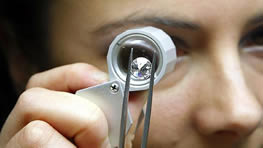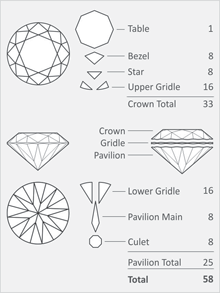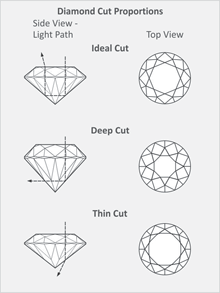Our Valuation Process
Our diamond experts perform a professional valuation process on your diamonds.

Distinguish non diamond from diamond
We try to first check if the diamond is not cubic zirconia (CZ) or other diamond imitation material. If confirmed that it is a diamond we proceed with pricing the diamonds.
Diamond grading
For smaller parcels we sort it into corresponding groups of shapes for example groups of round brilliants, princess cuts, old cuts, new cuts , rose cuts or broken stones.
For bigger diamonds we grade each diamond separately based on the 4 Cs.
Carat weight
 For any gemstone, the measuring unit of its weight is Carat. A carat is further divided in to 100 points. For example, a diamond measuring 50 points is ½ carat in weight or 0.50 ct. A diamond measuring 75 points in weight is ¾ carat or 0.75 ct in weight. The grading of a diamond begins right from this point.
For any gemstone, the measuring unit of its weight is Carat. A carat is further divided in to 100 points. For example, a diamond measuring 50 points is ½ carat in weight or 0.50 ct. A diamond measuring 75 points in weight is ¾ carat or 0.75 ct in weight. The grading of a diamond begins right from this point.
The easiest way to determine the weight of a diamond is: 1 carat is equal to 0.2 gram.
Again, there is wide range of possibilities that two diamonds of the same shape cut from the common rough piece can differ based upon the level of proportions.
Well, pricing of the diamond do not follow static logic like bullion market. For example, one carat diamond costs more (more than double) than ½ a carat diamond as it’s rare to find a large piece of diamond.
Clarity
The second parameter within the famous 4 Cs is the clarity of a diamond. Mostly, it is determined by various factors like the number, nature, position, size and colours of internal characteristics as well as surface features. In most cases, diamonds are a piece of pure carbon but sometimes, in the process of crystallization, other minerals close by or even other bits of carbon forming more quickly may have become trapped within the cooling mass.
Clarity is measured on a scale ranging from loupe clean (flawless) to heavily included (I-3). The clarity of a diamond is graded by using 10X magnification under good lighting by an experienced grader.
The final clarity grade is usually determined by how easy the inclusions and blemishes are for the grader to see.
The popular tools used for clarity grading are the hand held loupe or microscope with 10X magnification system. Hence, we can say that the imperfections not filtered under 10X magnifications are not considered as imperfections.
The various grading codes and their meanings are as per under 10X magnification:
Colour
Ideally, a diamond should be a transparent gem piece. But still, as some of the stones are found with colour, the process of grading through colours become more important. The diamonds are measured on a scale ranging from no colour at all (D) to deeply coloured (Z).
After ‘Z’, the diamonds are found rich in colours which are popularly known as "fancy colours". The diamonds of popular colour are used as comparison stones for colour grading.
A machine called the "Colorimeter" is being used in colour grading at some places but nothing can beat the trained human eye.
As we all know that the valuation of a diamond is not just finalized by its colour grade. Hence, sometimes a visible tint in K and above can still be more beautiful and of better value if it carries better clarity and cut. Only diamonds graded N and onwards have a tint that is visible through the naked eye.
The most popular colour tints are combinations of pink, blue, brown, yellow, orange, green and red. Among these yellow is the most common shade while other rare shades are red, blue and green.
Cut


Most of the times forgotten or ignored "C" is the cut of a diamond which ensures brilliance and sparkle of the gemstone. Cut is used to grade a stone for its overall appearance. For a non technical person, very simply, if a diamond cannot catch your eye or attracts you in a flash time, it is not a good cut. A piece of diamond cut perfectly blinds you with its charm.
A skilled master cutter can only get the perfect cut diamond from the raw or rough. The way and volume of sparkle of a diamond are purely based upon its cut.
Reflection of light is always maximum in a well cut diamond piece and therefore it sparkles at its best.
The light escapes towards the sides or the bottoms in shallow cut and deep cut diamonds. Hence, their sparkle also gets affected. The traditional round brilliant diamond is the only type where we can define range of proportions which can result in to a well-cut stone. The same kind of range of proportion is not available for fancy shape diamonds like princess cuts, pears, emeralds, etc.
CUT and SHAPE are two different confusing terms. SHAPE means outward look of the diamond such as round, oval, emerald and more while CUT is about the reflective qualities of the diamond.
When looking at the proportions of a diamond, a trained eye would distinguish between an Ideal cut and a deep or shallow cut.
The cuts are usually defined by terms like Ideal Cut, Premium Cut, Fine Cut, Good Cut, Fair Cut, and Poor Cut. Ideal, premium, fine and good cut diamonds are of more value as they reflect most of the light. Fair and poor cut diamonds reflect only a portion of the light enters. The Ideal, Premium, Fine and Good cut grades vary respectively, from maximum brilliance, to reflecting most of the light that enters the diamond. Diamond proportions graded as Fair or Poor mean that the diamond reflects only a fraction of the light that enters it.
Sell your diamonds
 With our head office based in the Hoveniersstraat in Antwerp, a regional office in Mumbai and buyers across Europe we will try to give the best possible prices and service to all our customers.
With our head office based in the Hoveniersstraat in Antwerp, a regional office in Mumbai and buyers across Europe we will try to give the best possible prices and service to all our customers.
Buy certified diamonds
 LD Gems along with its professional team operates across the whole of Europe offering simple and quick service in order to maximize the value of the customer's recycled diamond stock. We will pay you the best price.
LD Gems along with its professional team operates across the whole of Europe offering simple and quick service in order to maximize the value of the customer's recycled diamond stock. We will pay you the best price.
Make an inquiry
 If you have a question about selling your diamonds or if you want to buy diamonds from us don't hesitate to call or use our contact form. We will contact you as soon as we can.
If you have a question about selling your diamonds or if you want to buy diamonds from us don't hesitate to call or use our contact form. We will contact you as soon as we can.Call us on: +32 (0) 488 413 229
